1-2-1-1 Basics
 | 1 1-2-1-1 fullcourt press, trap on the inbounds pass (thumbs down), keep trapping on a perimeter pass, the press is broken on a gut pass or penetrating dribble, fall back into a man-to-man or zone defence. X4 is on the ball, shading middle. X2 takes the first attacker on the left, in an intercept position, pushing 1 towards the baseline. X3 covers the area on the right back to the top of the 3-point line extended, denying any attacker in his square. X1 matches up with the next ballside attacker (if 4 runs the baseline, X1 changes sides). X5 has the last attacker, and is the safety. Dean Smith - use the 1-2-1-1 on a dead ball or made free throw, X5 is on the ball and X3 on the left (tall players in a trap), with X1 and X2 as interceptors (speed and quickness). On a perimeter pass, try to double-team the receiver, on a gut pass, or once the ball penetrates the hash marks in their backcourt, the press is broken, the defence sprints back, picking up man-to-man. Keith Dambrot - Fullcourt 1-2-1-1 (YouTube) - when you press there are no absolutes, it's all reaction, but the answer is two on the ball, two interceptors, and a protector. You can make it so X5 is always back and X1 goes sideline to sideline, or you can play them on a string, which he prefers. Coach Nick - Toronto Raptors (YouTube) - the wings can allow an inbounds pass to a corner or face guard and not allow a pass. See Defences - Black and grey (a 1-2-2), 1-2-1-1 Canada, Havoc, Tennessee, Maryland, Alan Lambert, also Kentucky and Thumbs up (trapping off the dribble), and YouTube playlist - 1-2-1-1 diamond press. |
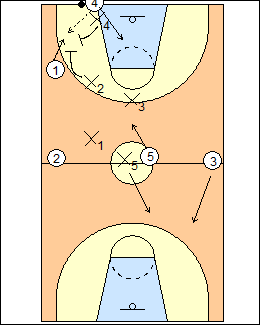 | 2 a) X2 and X4 trap an inbounds pass to 1, X1 and X3 are the interceptors. Bruce Pearl - don't trap an inbounds pass to the weakside, it's too far for X4 to run. Billy Tubbs - always trap the inbounds pass, even to the long corner. Shaka Smart - they're still trapping if the inbounds pass goes to the weakside corner. Alan Lambert - variation - instead of trapping on the inbounds pass, X4 denies a pass back to the inbounder. Derek Kellogg - Diamond press (YouTube) - if the inbounds pass goes weakside we're morphing into a 2-2-1. Dambrot - don't trap big players as much as little players (big players want to pass, so why trap), - if you're not close, don't trap, - every 4th time they throw it in, don't trap, the tendency is for 1 to catch and throw it right back to 4, X4 fakes a trap, they will probably throw it right to him, - don't get beat in the same direction 3 times in a row, e.g. the 3rd time 1 tries to throw out of a trap to 4, X3 takes that away. |
 | 3 X1 and X3 take away the sideline and short middle, safety X5 covers long middle (the basket). Shaka Smart - if 1 pivots baseline, X3 can really cheat a pass to 4. Variation - X3 moves up to cover ball reversal, X5 covers 5, leaving open a skip pass to 3. Canada Basketball - a pass back to the inbounder is often least contested by interceptor X3, especially if the inbounder is a post player who is not a threat to dribble the ball. Vivian Stringer - X1 becomes the thief, always behind the trap. Matt Hackenberg - 1-2-1-1 diamond press (YouTube) - X1 and X3 read 1's shoulders (sideline-middle-baseline). X1 takes any pass completed outside a trap zone (including an inbounds pass). |
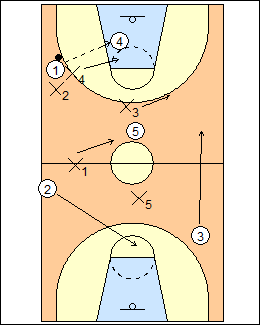 | 4 b) Get back to a 1-2-1-1 set on ball reversal to 4, X1 mirrors the ball, covering middle, X5 protects the basket (4 could throw long, he is not double-teamed). A coaching option is "one and done" - sprint back into the halfcourt defence on a completed pass out of the trap, or defenders are unable to set the trap. Shaka Smart - X3 stunts at 4 and goes with 3. They don't want to allow a pass out of the first trap to 4, but they will get a second trap. Dean Smith - on a reversal pass to 4, X3 could intercept it if 1 turns his back to make the pass, otherwise move back to a 1-2-1-1 alignment. Jim O'Brien - the press stays on for any backward pass. See Defence - White and black match-up press. |
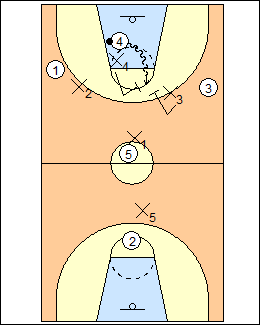 | 5 Look to trap if 4 drives or passes the ball. Dean Smith - begin double-teaming if 4 passes to 3. Usually the inbounder is a big not known for his dribbling ability, if the inbounder is a dribbler, X4 could contain him with help from X2 and X3. Rick Pitino - if the inbounder is the other team's center (their 5), the diamond moves back and plays the passing lanes, otherwise the inbounder is pressured, encouraging an uncontrolled dribble. See Thumbs up. |
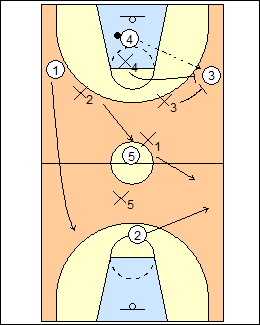 | 6 |
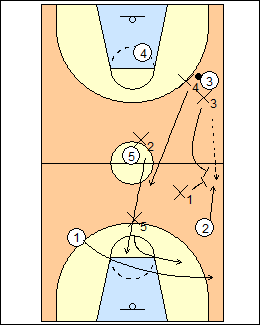 | 7 c) Optionally trap again on a pass up the sideline, X1 traps with X3. X5 covers any sideline attacker, then X2 is the safety. Billy Tubbs - X2 takes the sideline (if there is an attacker on the sideline), X5 is still the safety. Optionally X5 can take the sideline and X2 drops back, but Tubbs has been burned too many times on that. See Defence - Billy Tubbs fullcourt zone. |
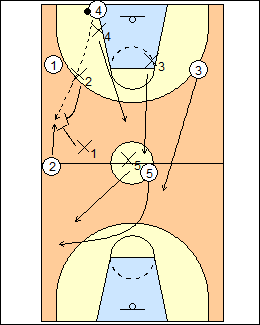 | 8 d) If an inbounds pass is made over X2 to 2, X2 can come back to double-team with X1. Dean Smith - if an inbounds pass is made over X2 to 2, X2 can come back to double-team with X1, X5 and X4 would be interceptors, and X3 the goaltender. See Defence - 1-2-1-1 Australia (50 off).  |
This page was made with Basketball playbook from Jes-Soft